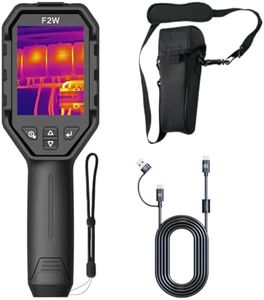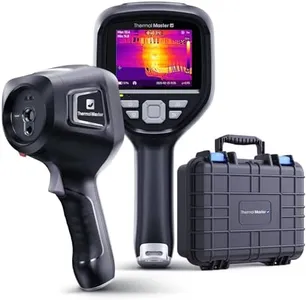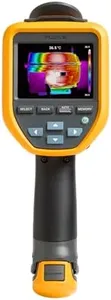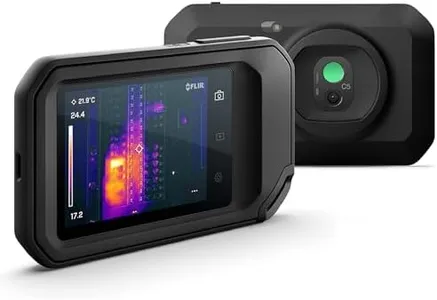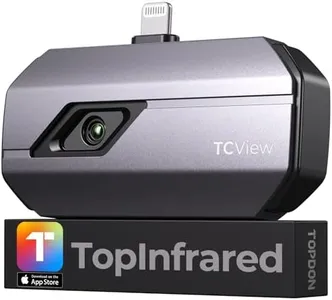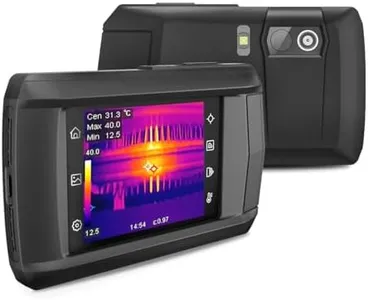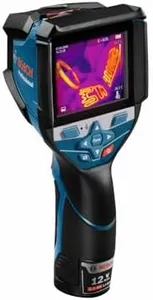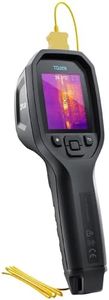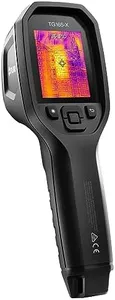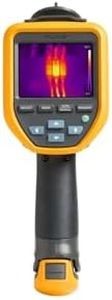10 Best Thermal Cameras 2025 in the United States
Our technology thoroughly searches through the online shopping world, reviewing hundreds of sites. We then process and analyze this information, updating in real-time to bring you the latest top-rated products. This way, you always get the best and most current options available.

Our Top Picks
Winner
FLIR E8-XT - Commercial Thermal Imaging Camera with WiFi. High Resolution Infrared Camera Ignite Cloud
The FLIR E8-XT is a handheld thermal camera designed for commercial and outdoor use, offering a solid resolution of 320 × 240 pixels. This provides clear thermal images that help you quickly spot temperature differences and hidden issues. It features patented MSX technology, which overlays visible details over the thermal image, making it easier to understand what you’re looking at without needing expert interpretation. The camera covers a wide temperature range from -20°C to 550°C (-4°F to 1022°F), suitable for many industrial and maintenance tasks.
Its wireless connectivity via WiFi and Bluetooth allows easy image sharing and cloud storage through the FLIR Ignite app, streamlining workflow and reducing manual file handling. Battery life is decent, powered by a rechargeable lithium-ion battery, making it portable enough for fieldwork. The device weighs around 1.3 pounds and is built with an IP54 rating, meaning it can handle some dust and water splashes, though it’s not fully rugged for harsh environments. While the 320 × 240 resolution is good for many uses, higher-end models offer better detail if you require very precise imaging.
The FLIR E8-XT balances user-friendly features with reliable performance, making it a practical choice for professionals needing quick diagnostics, maintenance checks, and outdoor security inspections without overwhelming complexity.
Thermal Master Handheld Thermal Camera, 512×384 X³IR Resolution, Thermal Imaging Camera with 2MP Visual Camera, 640×480 3.5" IPS Screen Thermal Imager with Laser, -4℉to 1022℉, 60Hz, 40mK(Thor 002)
Most important from
98 reviews
The Thermal Master Handheld Thermal Camera stands out with its sharp 512×384 thermal resolution, significantly higher than many entry-level models, helping users spot even small temperature differences clearly. Its thermal sensitivity of 35mK means it can detect subtle heat variations, which is valuable for detailed inspections in electrical, HVAC, or building maintenance tasks. The temperature range from -4℉ to 1022℉ covers most industrial and commercial needs, and the camera can measure six points simultaneously for more thorough analysis. The 3.5-inch IPS display with 640×480 resolution shows images crisply and with a smooth 60Hz refresh rate, making it easy to track moving targets or fluctuating temperatures. The inclusion of a 2MP visual camera and laser aiming assist enhances precision during inspections.
Connectivity is strong, offering USB and WiFi options to transfer images and videos, plus 32GB built-in storage which is generous for fieldwork. The device supports voice notes and QR code tagging, helping organize data conveniently. The camera features an IP54 rating, which protects against dust and splashes but is not suitable for very harsh environments or heavy rain. The 4.3mm lens extends viewing range by about a third and includes 4X digital zoom. Battery life is impressive at over 10 hours with fast charging, supporting long days on site.
This thermal camera is a solid choice for professionals needing reliable, detailed thermal imaging with good connectivity and portability, though those requiring rugged outdoor use might want to consider alternatives.
Most important from
98 reviews
Fluke TiS75+ 27HZ, Thermal Imager
The Fluke TiS75+ 27HZ thermal imager stands out due to its rugged build and reliability, essential for professionals in demanding environments. It has an IP54 rating, making it resistant to water and dust, and it can withstand drops from up to 2 meters. This durability ensures that it remains functional even in tough working conditions.
The camera's thermal sensitivity (NETD), resolution, and wide temperature range enhance its capability to detect and diagnose issues accurately, making it suitable for proactive maintenance programs. Its field of view and image refresh rate are designed to provide clear and detailed thermal images, which are crucial for precise inspections. The asset tagging and voice annotation features allow users to organize and document their inspections efficiently, saving time and increasing productivity.
At 7.55 pounds, it is relatively heavy, which might be cumbersome for prolonged use. While its modern design and interface make it user-friendly, the premium price point may be a consideration for budget-conscious buyers. The Fluke TiS75+ is best suited for professionals who need a reliable, durable, and feature-rich thermal camera for accurate and efficient maintenance inspections.
